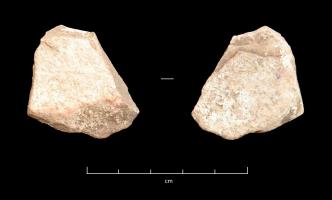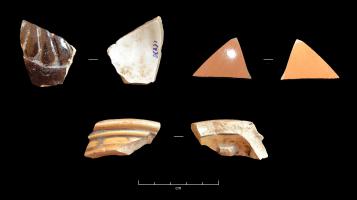
Within the assemblage, there are five potsherds whose technical features are so different from the others that they are grouped together and classified as 'unidentified' types. These may be non-local imports to the area, or local ceramics produced more recently that have found their way into the archaeological record.
Only one bodysherd belongs to this group. It is characterised by a very fine, compact and hard paste. No information on the shaping of this vessel could be gleaned from this sherd. A kind of white slip (2.5Y/1-8.5 white) is applied to both surfaces.

This group comprises potsherds characterised by the use of an alkaline clay decorated with a glaze. However, all three have different technical features in terms of type and colour of glaze and of decoration. One has a brownish-black glaze (5YR-3/3 dark reddish brown, 5YR-3/2 dark reddish brown, 7.5YR-3/3 dark brown) on the external surface and a whitish glaze (7.5YR_/1-9.5 white) on the internal surface. The external decoration is a pattern in low relief that could be moulded, composed of pointed long leaves. The second potsherd, a fragment of body, displays an orange (7.5YR-7/8 reddish yellow) glaze on both surfaces while the third, a base fragment, has a buff-cream (10YR-8/6 yellow) glaze on both surfaces. In addition, this sherd has ridges on the external surface.

These three potsherds could come from China or South-east Asia. Indeed, the first one is similar to examples from Dehua, Guangdong, and other Qing dynasty wares from China.
The last type of unidentified pottery is characterised by a very fine, compact, very hard to cut paste that is identified as Fabric Group 12. The bodysherd is too small to determine the shaping technique; however, the sides are extremely regular. Surfaces are soapy but still rough to the touch. It has been fired in an oxidising atmosphere (colour of surfaces 2.5YR-7/6 light red). The internal surface displays incised decorations: parallel lines combined with slightly oblique/vertical lines that are less marked.

| Class/variant | Paste | Shaping | Surface treatment and aspect | Firing |
|---|---|---|---|---|
| Class 1 variant 1 | medium texture, sand as temper | wheel? | white concretions | oxidised |
| Class 1 variant 2 | finer texture, organic temper? | wheel? | white concretions | oxidised |
| Class 1 variant 3 | medium texture, sand as temper | wheel? | whitish slip, incised decoration | oxidised |
| Class 2 variant 1 | fine to medium texture | combined techniques (coils, slow wheel, convex mould?) | red slip of good quality, smoothing-burnishing | oxidised |
| Class 2 variant 2 | fine to medium texture | combined techniques (coils, slow wheel, convex mould?) | red slip of medium to poor quality, smoothing-burnishing | oxidised |
| Class 2 variant 3 | fine to medium texture | combined techniques (coils, slow wheel, convex mould?) | red slip of good to poor quality, incised-appliqué-impressed decoration | oxidised |
| Class 2 variant 4 | fine to medium texture | combined techniques (coils, slow wheel, convex mould?) | red slip of medium quality mixed with mica powder | oxidised |
| Class 2 variant 5 | fine to medium texture | combined techniques (coils, slow wheel, convex mould?) | impressed decoration | oxidised |
| Class 2 variant 6 | fine to medium texture | combined techniques (coils, slow wheel, convex mould?) | mud slip mixed with mica powder | oxidised |
| Class 3 variant 1 | fine to medium texture, compact | wheel? And combined techniques (wheel-coiled) | micaceous slip with mostly specks, smoothing | oxidised |
| Class 3 variant 2 | fine to medium texture, less compact | wheel? And combined techniques (wheel-coiled) | micaceous slip with mostly specks, smoothing | oxidised |
| Class 4 | very fine sandy texture, compact, specks of mica | undetermined | soapy | oxidised |
| Class 5 variant 1 | mica flakes as temper, medium to coarse texture | combined techniques (wheel-coiled, mould, paddle and anvil) | mica flakes and specks visible in surfaces, reddish-brown slip, smoothing | oxidised |
| Class 5 variant 2 | mica flakes as temper, medium to coarse texture | combined techniques (wheel-coiled, mould, paddle and anvil) | less mica flakes and specks visible in surfaces, grey and reddish-brown slip, smoothing | oxido-reduced? |
| Class 5 variant 3 | mica flakes as temper, medium to coarse texture | combined techniques (wheel-coiled, mould, paddle and anvil) | mica flakes and specks visible in surfaces, red to black slip, impressed decoration ('flower' or 'sun') | oxidised |
| Class 5 variant 4 | fewer mica flakes as temper, medium to coarse texture | combined techniques (wheel-coiled, mould, paddle and anvil) | fewer mica flakes and specks visible in surfaces, black slip, smoothing, incised decoration (lines) | reduced |
| Class 6 variant 1 | medium to coarse texture | wheel and/or combined techniques (wheel-coiled?) | red slip, smoothing | oxidised |
| Class 6 variant 2 | coarse texture | wheel and/or combined techniques (wheel-coiled?) | black slip, smoothing | reduced |
| Class 6 variant 3 | coarse texture | wheel and/or combined techniques (wheel-coiled?) | grey surfaces (black slip disappeared?), smoothing | reduced |
| Class 7 variant 1 | medium to coarse texture, organic temper | combined techniques (hand-stretching plates, coils, others?) | thick sides, smoothing | oxidised |
| Class 7 variant 2 | medium to coarse texture, organic temper | combined techniques (hand-stretching plates, coils, others?) | thick sides, red slip sometimes mixed with mica powder, smoothing, applique decoration | oxidised |
| Class 8 | fine texture, compact | undetermined | smoothing | oxidised |
| Class 9 | very fine texture, compact | combined techniques (wheel-coiled) | thin sides, red slip of good quality, smoothing-polishing | oxidised |
| Class 10 variant 1 | medium to coarse texture, sand and organic as tempers | combined techniques (wheel-coiled, plates, other?) | smoothing, incised and impressed decoration | oxidised |
| Class 10 variant 2 | medium to coarse texture, sand and organic as tempers | combined techniques (wheel-coiled, plates, other?) | red slip and/or mica slip made with mica powder, smoothing, incised and impressed decoration | oxidised |
| UnID 1 | very fine texture, compact | undetermined | white slip | oxidised |
| UnID 2 | alkaline clay | wheel? | glaze, moulded decoration? | oxidised and oxido-reduced? |
| UnID 3 | very fine texture, compact | undetermined (wheel?) | incised decoration | oxidised |
Internet Archaeology is an open access journal based in the Department of Archaeology, University of York. Except where otherwise noted, content from this work may be used under the terms of the Creative Commons Attribution 3.0 (CC BY) Unported licence, which permits unrestricted use, distribution, and reproduction in any medium, provided that attribution to the author(s), the title of the work, the Internet Archaeology journal and the relevant URL/DOI are given.
Terms and Conditions | Legal Statements | Privacy Policy | Cookies Policy | Citing Internet Archaeology
Internet Archaeology content is preserved for the long term with the Archaeology Data Service. Help sustain and support open access publication by donating to our Open Access Archaeology Fund.